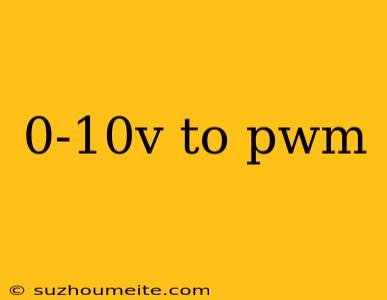0-10V to PWM Converter: Understanding the Concept and Applications
Introduction
In industrial automation, process control, and building automation, 0-10V analog signals are commonly used to transmit sensor data or control signals between devices. However, many modern devices, such as LEDs, motors, and valves, often require PWM (Pulse Width Modulation) signals to operate efficiently. This article will explore the concept of 0-10V to PWM converters, their working principle, and applications.
What is 0-10V Analog Signal?
A 0-10V analog signal is a type of signal that varies in voltage between 0V and 10V to represent a range of values. This type of signal is commonly used in industrial control systems to transmit sensor data, such as temperature, pressure, or flow rate. The 0-10V signal is typically used to control actuators, such as valves, pumps, or motors, to adjust their operating conditions.
What is PWM Signal?
PWM is a digital signal that consists of a series of pulses with varying widths to represent a range of values. In a PWM signal, the frequency remains constant, and the width of the pulse (duty cycle) varies to convey information. PWM signals are widely used in power electronics, motor control, and lighting applications.
Working Principle of 0-10V to PWM Converter
A 0-10V to PWM converter is an electronic device that converts a 0-10V analog signal into a PWM signal. The converter consists of an analog-to-digital converter (ADC), a microcontroller, and a PWM generator.
Here's how it works:
- Analog-to-Digital Conversion: The 0-10V analog signal is converted into a digital signal using an ADC.
- Microcontroller Processing: The digital signal is processed by a microcontroller, which interprets the signal and determines the corresponding PWM duty cycle.
- PWM Generation: The microcontroller generates a PWM signal with the calculated duty cycle, which is then sent to the output.
Applications of 0-10V to PWM Converter
0-10V to PWM converters have various applications in:
1. Industrial Automation
In industrial automation, 0-10V to PWM converters are used to control actuators, such as valves, pumps, or motors, based on sensor data.
2. Lighting Control
In lighting control systems, 0-10V to PWM converters are used to control LED brightness or color temperature based on input signals from sensors or controllers.
3. HVAC Systems
In HVAC systems, 0-10V to PWM converters are used to control fan speeds, valve positions, or pump speeds based on temperature, pressure, or flow rate sensor data.
Conclusion
In conclusion, 0-10V to PWM converters play a crucial role in industrial automation, process control, and building automation by enabling the conversion of analog signals into PWM signals. Understanding the working principle and applications of these converters can help designers and engineers develop more efficient and effective control systems.
